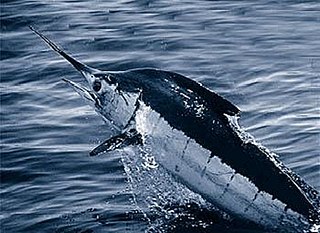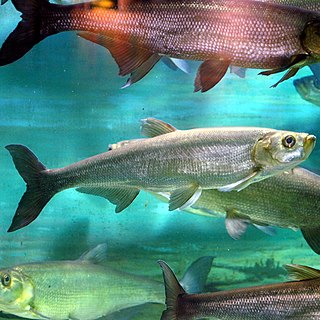
A tuna is a saltwater fish that belongs to the tribe Thunnini, a subgrouping of the Scombridae (mackerel) family. The Thunnini comprise 15 species across five genera, the sizes of which vary greatly, ranging from the bullet tuna up to the Atlantic bluefin tuna, which averages 2 m (6.6 ft) and is believed to live up to 50 years.

Mackerel is a common name applied to a number of different species of pelagic fish, mostly from the family Scombridae. They are found in both temperate and tropical seas, mostly living along the coast or offshore in the oceanic environment.

Herring are various species of forage fish, belonging to the order Clupeiformes.

The term carp is a generic common name for numerous species of freshwater fish from the family Cyprinidae, a very large clade of ray-finned fish mostly native to Eurasia. While carp are prized quarries and are valued as both food and ornamental fish in many parts of the Old World, they are considered trash fish and invasive pests in many parts of Africa, Australia and most of the United States.

The International Union for Conservation of Nature (IUCN) Red List of Threatened Species, also known as the IUCN Red List or Red Data Book, founded in 1964, is an inventory of the global conservation status and extinction risk of biological species. A series of Regional Red Lists, which assess the risk of extinction to species within a political management unit, are also produced by countries and organizations.

Sardine and pilchard are common names for various species of small, oily forage fish in the herring suborder Clupeoidei. The term 'sardine' was first used in English during the early 15th century; a somewhat dubious etymology says it comes from the Italian island of Sardinia, around which sardines were once supposedly abundant.

Sprat is the common name applied to a group of forage fish belonging to the genus Sprattus in the family Clupeidae. The term also is applied to a number of other small sprat-like forage fish. Like most forage fishes, sprats are highly active, small, oily fish. They travel in large schools with other fish and swim continuously throughout the day.

The billfish are a group (Xiphioidea) of saltwater predatory fish characterised by prominent pointed bills (rostra), and by their large size; some are longer than 4 m (13 ft). Extant billfish include sailfish and marlin, which make up the family Istiophoridae; and swordfish, sole member of the family Xiphiidae. They are often apex predators which feed on a wide variety of smaller fish, crustaceans and cephalopods. These two families are sometimes classified as belonging to the order Istiophoriformes, a group which originated around 71 million years ago in the Late Cretaceous, with the two families diverging around 15 million years ago in the Late Miocene. However, they are also classified as being closely related to the mackerels and tuna within the suborder Scombroidei of the order Perciformes. However, the 5th edition of the Fishes of the World does recognise the Istiophoriformes as a valid order, albeit including the Sphyraenidae, the barracudas.

Hemiculter is a genus of freshwater ray-finned fish belonging to the family Xenocyprididae, the East Asian minnows or sharpbellies. The species in this genusare found in eastern Asia from Siberia to Viet Nam. The type species is the sharpbelly, Culter leucisculus. The name is derived from the Greek word hemis, meaning "half", and the Latin word culter, meaning "knife".

The sharpbelly or wild carp, sharpbelly, or common sawbelly, is a tropical freshwater and brackish water fish belonging to the family Xenocyprididae. It originates in large streams and reservoirs in China, Taiwan, Japan, Hong Kong, Korea, and the Amur River basin. It has become established as an exotic species in several other countries, including Iran, Afghanistan, and the former Soviet Union, where it has displaced local species. It was originally described as Culter leucisculus by S. Basilewsky in 1855, and has also been referred to as Chanodichthys leucisculus and Hemiculter leucisculus warpachowskii in scientific literature.
Hemiculter elongatus is a tropical freshwater fish belonging to the family Xenocyprididae. It is known only from the Ky Cùng River in Lang Son Province, northern Vietnam. It was originally described by Nguyen & Ngo in 2001.

An anchovy is a small, common forage fish of the family Engraulidae. Most species are found in marine waters, but several will enter brackish water, and some in South America are restricted to fresh water.
Hemiculter krempfi is a species of ray-finned fish in the genus Hemiculter. It is known only from the Cai River in Khanh Hoa Province and the Da Rang River in Phu Yen Province of central Vietnam. Here it is found mainly over sand substrates and is infrequently encountered in fish markets.
Hemiculter tchangi is a species of freshwater ray-finned fish belonging to the family Xenocyprididae, the East Asian minnows or sharpbellies. This species has only been recorded from the upper reaches of the Yangtze River in Sichuan.
Siniichthys varpachovskii is a species of ray-finned fish in the genus Siniichthys from the Khalkh River and Lake Buir in Mongolia and Lake Hulun in China. It may also occur in the upper drainage of the Argun River in Russia and China.
The Ussuri sharpbelly is a temperate freshwater fish belonging to the subfamily Cultrinae of the family Cyprinidae. It originates in the Amur River basin in Asia. It was originally described as Culter lucidus by B. I. Dybowski in 1872, and has also been referred to as Hemiculter leucisculus lucidus in scientific literature.

The Cultrinae are one of at least 13 subfamilies of cyprinid fish. It contains ten genera.

Paradiplozoon hemiculteri is a species of monogenean of the family Diplozoidae. As in all species of this family, the bodies of the two hermaphroditic members of a couple are permanently fused for life.













